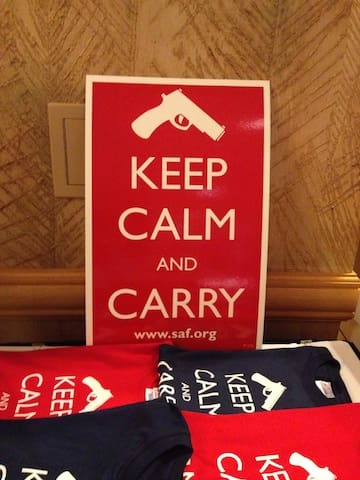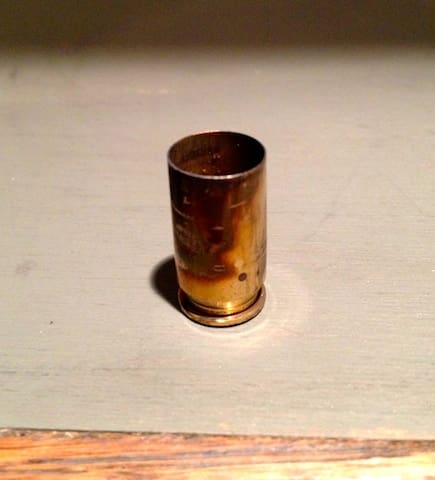Unholstering at home after a long range session with my FFL BFF, I heard a strange rattling noise. My first thought: something’s broken inside my gun or my Raven Concealment holster. I reholstered and unholstered my Glock 30SF. There it was again. And again. How was that possible? The front site was still on the Glock and the Raven’s a Kydex holster; it has as many internal parts as a rock. So I dropped trou [ladies look away now], took off the holster, turned it upside down. There it was: a spent shell casing. Somehow, the brass had flown out of my Glock and landed inside my temporarily empty outside-the-waistband holster . . .
What are the odds? I’ve fired approximately 7k rounds out of that gun, wearing the same holster. I’ve practiced drawing and firing (and not firing) from the Raven thousands of times. This is the first and only time—in my entire shooting history—that a casing has leaped into my holster.
So, a rare event. Thankfully detected and corrected.
But what if the Glock had somehow got hung-up on the casing inside the holster? What if the casing had become jammed in the barrel? Then, if I needed my gun for a defensive gun use (DGU) . . . That might’ve gone very badly indeed.
This is not the first time strange things have happened to my carry system. I keep a spare mag in my left front pocket. Nothing else. No keys, parking garage tickets, lint, change, nada. And yet one time I brought the mag out for practice and discovered that a dime had wedged itself underneath the feed lips.
Yes, I blame the dime. The wider point: shit happens. Although nobody expects the Spanish Inquisition, armed self-defenders should expect the unexpected. And be ready to work their way though it.
I taught Steve that lesson last night, before The Mystery of the Flying Brass (wow Scoob). I was teaching him how to tap, rack, attack (and NOT attack). As a newbie would, Steve got flustered in the middle. He did a kinda half rack before tapping. He looked over at me and hesitated.
“Don’t look at me” I yelled. “Keep going! Find an answer!”
In other words, keep calm and carry on. Or, if you’re experiencing a full adrenal dump, just carry on.
What are the odds that some weird ass shit will happen to you in a DGU? Or that you will screw-up somehow? If you train well and carry consistently, low. If you don’t train or train badly or don’t train frequently, higher. If your carry system is flawed, higher. If your DGU happens “out of the blue” higher still.
If you’re in a complex physical environment—say, a restaurant you’ve never been in before—higher again. If the incident doesn’t ramp-up smoothly (i.e. the violence escalates in fits and starts), higher.
Taken as a whole, the odds of a Murphy’s Law incident (e.g., you trip and fall over a baby bottle) are low. But a lot higher than you might imagine. Which is why it’s important to realize the wisdom of John Lennon’s adage “life is what happens when you’re making other plans.”
The key: stay focused on the goal, not the method. You want to survive a violent attack. If you do so exactly as you’ve trained to do, good for you! If something goes wrong and you have to recalibrate or improvise, clumsily, and you survive, result!
To that end, get out of your comfort zone. Train for failure. Have a pal put snaps caps in your mags. Randomly. Secretly. Practice what you’re BAD at (e.g., weak hand shooting). Practice off the range with a blue gun. Remove your glasses. Shoot someone else’s gun.
At the end of the day, you need to know that you can do whatever it is you need to do to survive a violent attack. Even if you don’t know what that is.






When my son was learning how to ride a motorcycle, I figured it was time to let him in a the simplest truth of the human condition. He was so excited when he threw his short leg over the side of the Honda XL80 that his tension was palpable. I gently placed my hand on his shoulder and made direct eye contact with him:
“Just so you know, the moment you climbed on this machine, you died.” He looked at me with the puzzled expression of a nine year old and raised his gloved hands in a ‘WTF?’ sort of way, so I explained. “You resigned yourself to fate when you decided to ride. Just understand that no matter what you do, no matter what happens, you have to keep going. If you hesitate or stop, you will only make the unthinkable happen that much faster.”
He has since gone on to many different ‘firsts’ and looks forward to a lifetime of many more. At the tender age of 9 he learned what many adults still fail to grasp.
Hesitation will kill, be it riding a motorcycle, cliff diving or just mundane practice with a holstered weapon. If you start, you are in the pipe and there is only one way out.
“Just understand that no matter what you do, no matter what happens, you have to keep going. If you hesitate or stop, you will only make the unthinkable happen that much faster… If you start, you are in the pipe and there is only one way out.”
— The fatherly advice of the year award to you Sir.
All good sound advice! I’d add practice shooting with your weak hand, practice reloading with the opposite hand as well. We should all be able to shoot and reload at a reasonable skill level with either hand, because one never knows if you are going to get wounded in your strong hand. People (including bad guys) tend to zero their focus on the weapon in your hand and shoot at it.
A friend of mine practiced in the dark. Loading, clearing, indeed shooting at a barely lit target by flashlight in his other hand.
When practicing with my carry gun, I don’t hesitate to use cheap ammo that is known to jam occasionaly in it. It gives me much-needed and totally spontaneous unexpected opportunities to practice dealing with it quickly and smoothly. I was so flustered the first time it happened I swore not to use that ammo, but quickly came to my senses and realized “Hey, this is a *good* thing!”
Very good concept. Also investing in a few inert “Cap-spring” type rounds and having a buddy load them randomly for you is a great way to train as well. I like to hand over two magazines, one that has no inert rounds and one that has the second or third round inert, and then two more sequintial after that a few rounds later. They race through the first mag, expecting a failure, and finish, hesitantly. Load the second, get the failure right away and get a little flustered, then the double failure and the real test begins. Works everytime.
Here’s the best malfunction drill that I’ve come across:
http://Www.youtube.com/watch?v=BfyULpEhmug
Stealing two lines here. 1st. “No plan survives first contact with the enemy.” Von Clausewitz.
2nd. “Improvise, adapt, overcome.” Eastwood.
When I go to the range, I always load magazines the hard way, by hand, without one of those plastic helpers. This helps to ensure that my hands have the muscle memory to reload a magazine if necessary. My first pistol instructor suggested this and I’ve never had a reason to change.
Want that poster, where do I get it?
I believe the address is at the bottom of the poster.
The few seconds it takes to “tap, rack, attack” could be fatal seconds. That’s why I carry a REVOLVER. In the event of a misfire, just pull the trigger again. If you can’t take a perp down with 5 or 6 rounds, you ain’t gonna have time for more anyway.
Comments are closed.